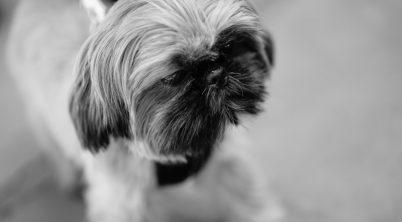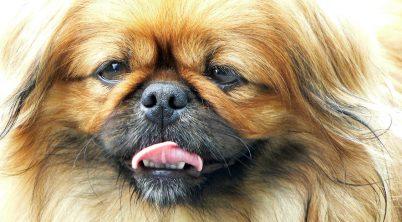Pekingese dogs are known for their unique and expressive appearance, which includes their distinctive eye structure. Due to their physical characteristics, Pekingese are prone to certain eye health issues, one of which involves the presence of eye mucus. This condition is often recognized by the accumulation of a sticky or pus-like discharge around the eyes. While some eye discharge is normal in dogs to help clear out debris, excessive mucus may signal an underlying problem that requires attention.
Eye mucus in Pekingese can stem from various causes such as infections, conjunctivitis, allergies, or even breed-specific issues like their pronounced facial structure leading to poor tear drainage. Owners need to be vigilant in observing their Pekingese for signs of eye distress, which could include squinting, excessive tearing, or a visible change in the eye’s appearance. It is important for a Pekingese’s facial hair to be well managed, as it can contribute to irritation and increase the risk of eye problems.
Ensuring the optimal eye health of a Pekingese involves regular grooming, preventative care, and prompt attention to any signs of eye irritation or abnormal discharge. Regular veterinary check-ups are essential to manage their eye health effectively, as early detection of eye issues can prevent them from escalating into more serious conditions. Addressing eye mucus promptly can help maintain the comfort and overall well-being of these beloved dogs.
Understanding Canine Ocular Anatomy
The ocular anatomy of canines, particularly in brachycephalic breeds like the Pekingese, presents unique characteristics and challenges. It is essential to recognize the anatomical distinctions that can predispose these dogs to specific eye conditions.
Brachycephalic Ocular Syndrome
Brachycephalic breeds, those with short noses and flat faces, such as Pekingese, tend to have a set of eye-related conditions collectively known as Brachycephalic Ocular Syndrome. Brachycephalic Ocular Syndrome typically affects the structure and function of the eyes and eyelids, often leading to issues such as prolapse of the nictitating membrane, also referred to as “cherry eye.” The nictitating membrane, or third eyelid, provides additional protection and tear production but can protrude abnormally in these breeds, necessitating veterinary attention.
| Feature | Function in Brachycephalic Breeds |
|---|---|
| Shallow Eye Sockets | Contributes to the prominence of the eyes. |
| Widened Palpebral Fissure | Leaves eyes more exposed and prone to injury or dryness. |
| Nictitating Membrane | Acts as a ‘windshield wiper’ for the cornea but can prolapse easily. |
Conjunctiva and Cornea
The conjunctiva and cornea are two critical components of canine ocular anatomy. The conjunctiva is the mucous membrane that covers the front of the eye and lines the inside of the eyelids. In Pekingese, the pronounced eyes can lead to greater exposure and potential irritation or infection of the conjunctiva. The cornea, the transparent front layer of the eye, is vital for vision, providing a barrier against dirt, germs, and other harmful particles. Brachycephalic breeds are at an increased risk of corneal ulcers due to their prominent eyes.
- Conjunctiva: Susceptible to infection due to increased exposure in brachycephalic breeds.
- Cornea: Requires lubrication and protection, which can be compromised in dogs with Brachycephalic Ocular Syndrome.
Common Eye Conditions in Pekingeses
Pekingese dogs are prone to several eye conditions, partly due to their distinct facial structure and eye shape. Careful attention to eye health is crucial in maintaining their overall well-being.
Conjunctivitis
Conjunctivitis, often referred to as pink eye, is marked by the inflammation of the conjunctiva, the mucous membrane covering the eye. Symptoms typically include red eyes, discharge, and pain. In Pekingeses, this can be caused by infections, allergens, or irritants like dust.
Keratoconjunctivitis Sicca (Dry Eye)
Keratoconjunctivitis Sicca, commonly known as dry eye, occurs when there’s inadequate tear production. Signs include discharge, discomfort, and red eyes. Without proper tear volume, the eyes are susceptible to infections and damage from inability to clear irritants.
Corneal Ulcers
Corneal ulcers are open sores on the eye’s surface due to injury or infection. These ulcers cause redness, pain, and can lead to vision loss if untreated. The prominent eyes of a Pekingese make them more likely to sustain such injuries.
Entropion and Ectropion
Entropion is a condition where the eyelid rolls inward, causing the eyelashes to rub against the cornea, potentially leading to irritation or ulcers. Ectropion, on the other hand, involves the eyelid rolling outward, exposing the sensitive inner eyelid and leading to dryness and inflammation.
Symptoms of Eye Issues
Recognizing the symptoms of eye issues in Pekingese is crucial for prompt treatment. This breed is susceptible to certain eye conditions, with various signs indicating potential problems.
Discharge and Redness
Discharge from the eyes of a Pekingese can range from clear and watery to thick, and possibly yellow or green, indicating infection. Redness is frequently a symptom of irritation or infection, often visible on the whites of the eyes and inner eyelids.
Squinting and Pawing
Pekingese may squint when experiencing discomfort in their eyes, a sign that should not be overlooked. Additionally, the dog might frequently paw at their eyes or rub their face against surfaces to relieve discomfort, which can further aggravate the condition.
Sensitivity to Light
When a Pekingese is affected by eye issues, they may exhibit sensitivity to light. This is noticeable when the dog is hesitant to face well-lit areas or blinks excessively in bright conditions.
Causes and Risk Factors
The health of a Pekingese’s eyes is influenced by several elements ranging from genetic predispositions to environmental factors. Recognizing these causes and risks can help in the maintenance and care of their distinct visual needs.
Genetics and Head Shape
The Pekingese breed is known for its distinctive flat face and large, prominent eyes—a result of selective breeding over centuries. This brachycephalic head structure places them at a higher risk for eye mucus accumulation and related problems due to the shape and shallow sockets of their eyes. Their facial folds can also trap dirt and moisture, leading to irritation.
Environmental Irritants
Exposure to various environmental irritants such as dust, pollen, and smoke can contribute to the overproduction of eye mucus. Pekingese dogs often exhibit increased sensitivity to these particles due to their protruding eyes, which can collect irritants more readily than those of other breeds.
- Common Irritants:
- Dust
- Pollen
- Smoke
Infections and Diseases
Infections like conjunctivitis and diseases such as dry eye syndrome (keratoconjunctivitis sicca) can cause significant mucus discharge in Pekingese eyes. The breed’s eye structure makes them particularly prone to such conditions, which can be catalyzed by allergens or pathogens like bacteria and viruses.
- Infections and Diseases to Watch Out For:
- Conjunctivitis
- Blepharitis
- Dry Eye Syndrome
Recognizing and addressing these causes and risk factors promptly can help mitigate the issues associated with excessive eye mucus in Pekingese dogs.
Diagnosing Eye Problems in Pekingeses
When a Pekingese exhibits symptoms such as eye discharge or redness, it is crucial they undergo a thorough diagnostic process to identify the underlying issue and formulate an appropriate treatment plan.
Veterinarian Examination
In the initial stage, a general practitioner veterinarian conducts a comprehensive eye exam to assess the Pekingese’s ocular health. Throughout this examination, they will look for common signs such as:
- Redness: Indicating possible inflammation or irritation.
- Discharge: Which can vary from clear to pus-like, suggesting infection or other conditions.
- Corneal clarity: Checking for any cloudiness or irregularities.
The veterinarian may employ tools like an ophthalmoscope to inspect the internal structures of the eye and a slit lamp biomicroscope for detailed evaluation. If the condition appears complex or if the initial treatment does not lead to improvement, referral to a specialist is the next step.
Specialist Consultation
For advanced diagnostics or treatment, a veterinary ophthalmologist—a veterinarian specializing in eye care—is consulted. These specialists have access to sophisticated diagnostic tools, such as:
- Tonometry to measure intraocular pressure
- Gonioscopy for angle assessment in the eye
- Advanced imaging modalities like ultrasound or MRI
Their in-depth assessment will determine if the mucus is due to conjunctivitis, corneal ulcers, dry eye syndrome, or other specific ocular diseases. The specialist may conduct tests for systemic diseases that could manifest as eye issues, ensuring a comprehensive approach to the Pekingese’s eye health.
Treatment Options
Effective treatment of Pekingese eye mucus is vital in ensuring comfort and preventing further complications. A comprehensive approach may include medication, surgeries, and home care strategies.
Medications and Surgeries
Medications:
- Eye Drops: To alleviate infection and control inflammation, antibiotic or antiviral eye drops are often prescribed.
- Artificial Tears: These can be used to keep the eyes lubricated, reducing the risk of dryness and irritation.
- Ophthalmic Ointment: An antibiotic ointment may be applied to treat bacterial infections contributing to eye mucus.
Surgeries:
- In severe cases, such as when dealing with corneal ulcers, surgery may be necessary to repair any damage and prevent vision loss.
Home Care and Management
Managing a Pekingese’s eye health at home is as crucial as medical treatment. Here are some key steps owners can follow:
- Regular Cleaning: Gently cleaning the Pekingese’s eyes with a damp cloth can help to clear away mucus accumulation.
- Hair Maintenance: Ensure the hair around the eyes is trimmed to prevent additional eye irritation.
- Monitoring: Keep a close watch on your dog’s symptoms and consult your veterinarian if the condition worsens.
Prevention and Long-Term Care
Preventative measures and consistent care are paramount in maintaining the ocular health of Pekingese dogs. These small canines require particular attention due to their increased risk of eye issues.
Regular Check-Ups
Veterinary Attention: Regular veterinary check-ups are essential to preemptively identify potential eye conditions. A veterinarian may recommend routine examinations every 6 months to ensure early detection and treatment. They may also prescribe steroids or other medications to manage inflammation if necessary.
Environmental Management
Eye Health and Immune System: Cleanliness and environmental control greatly benefit a Pekingese’s eye health. Owners should ensure the dog’s living area is free from dust and other irritants that can provoke eye issues. Additionally, maintaining a controlled indoor temperature can support the dog’s immune system, directly affecting ocular health.
Diet and Supplements
Fatty Acids: Incorporating essential fatty acids into the Pekingese diet supports their eye health. This can be achieved through high-quality commercial dog foods or supplements rich in Omega-3s, known for their anti-inflammatory properties, which can boost both the immune and ocular systems.
- Optimal food selection: Choose dog foods that list Omega-3 fatty acids as a key component.
- Supplement addition: Introduce supplements into the Pekingese’s diet to reinforce their intake of crucial nutrients for eye maintenance.
When to Seek Immediate Care
Eye mucus in Pekingese dogs can sometimes indicate a serious health condition that requires immediate veterinary attention. It is imperative for owners to recognize the signs of an emergency and know the steps they should take if their dog is in distress.
Recognizing Emergencies
When a Pekingese dog presents with eye mucus accompanied by redness, swelling, or any sign of pain, these symptoms may point towards an ocular emergency. Trauma to the eye or surrounding area might show as a sudden increase in discharge or a change in the mucus’s color or consistency. Owners should also be vigilant for behaviors indicating their Pekingese is experiencing discomfort, such as frequent squinting, rubbing at the eyes, or an aversion to bright lights.
Emergency Procedures
In the event of an ocular emergency, prompt action can help ensure the best possible outcome for a Pekingese. Owners should immediately:
- Contact their veterinarian or an emergency animal clinic to describe the symptoms and follow instructions provided.
- Prevent the dog from scratching or rubbing at their eye to avoid further irritation or injury.
- Transport the Pekingese to the veterinary clinic carefully, avoiding any sudden movements that might cause additional trauma to the eye.
It is crucial for Pekingese owners to act swiftly when they suspect an eye injury or infection to prevent any long-term damage to their pet’s vision.








